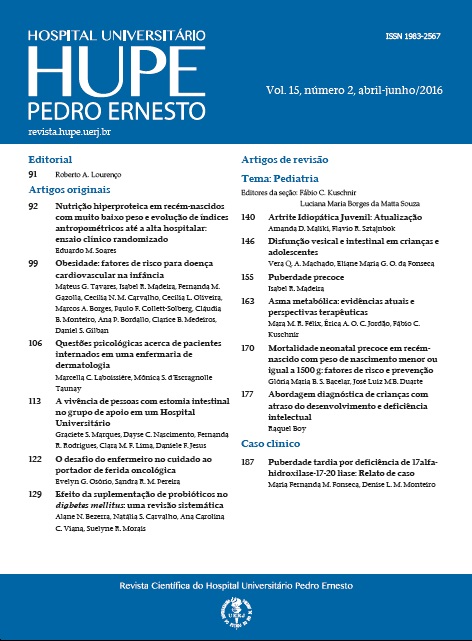Nutrição hiperproteica em recém-nascidos com muito baixo peso e evolução de índices antropométricos até a alta hospitalar: ensaio clínico randomizado
DOI:
https://doi.org/10.12957/rhupe.2016.28232Resumo
Objetivo: avaliar se o maior aporte proteico enteral durante a internação hospitalar promove melhora dos índices antropométricos na alta hospitalar.Método: ensaio clínico randomizado com 117 prematuros nascidos entre janeiro de 2009 e julho de 2013 com peso ≤ 1500 gramas e idade gestacional ≤ 32 semanas em uma unidade terciária de saúde, excluídos os nascidos com malformações graves, aferindo-se os índices antropométricos ao nascimento e na alta hospitalar. Randomizaram-se os prematuros em dois grupos: grupo 1 (n=53) submetido a um aporte proteicoenteral diário de 4,5 gramas/kg/dia e grupo 2 (n=64) 3,5 gramas/kg/dia.Resultados: verificou-se diferença estatisticamente significativa para retorno ao peso de nascimento (p=0,02), crescimento de escore-Z em relação ao peso de nascimento (p=0,03) e crescimento escore-Z em relação ao comprimento de nascimento (p=0,02) quando comparados o grupo 1 ao 2. Não houve diferenças estatisticamente significativas nas incidências de enterocolite necrotizante (p=0,70, OR 0,88), deficit ponderal na alta (p=0,27, OR 0,70), restrição de crescimento na alta (p= 0,39, OR 0,82) e deficit de perímetro cefálico na alta (p=0,45, OR 0,67).Conclusão: os participantes do grupo 1 apresentaram menor decréscimo de escores-Z em relação ao peso de nascimento e ao comprimento de nascimento quando comparados ao grupo 2, além de necessidade de menor tempo para recuperação do peso de nascimento. Não houve diferença entre os grupos para tempo de internação hospitalar, assim como para enterocolite necrotizante, deficit ponderal na alta, restrição de crescimento na alta e deficit de perímetro cefálico na alta.
Descritores: Prematuridade; Recém-nascido com muito baixo peso; Nutrição hiperproteica; Nutrição agressiva; Crescimento extrauterino restrito; Baixa estatura.
Referências
Hack M, Breslau N, Weissman B, et al. Effect of very low birth weight and subnormal head size on cognitive abilities at school age. N Engl J Med. 1991;325(4):231–7. http://doi.org/10.1056/NEJM199107253250403
Franz AR, Pohlandt F, Bode H, et al. Intrauterine, early neonatal, and postdischarge growth and neurodevelopmental outcome at 5.4 years in extremely preterm infants after intensive neonatal nutritional support. Pediatrics. 2009;123(1):e101–9. http://doi.org/10.1542/peds.2008-1352
Hay WW. Early postnatal nutritional requirements of the very preterm infant based on a presentation at the NICHD-AAP workshop on research in neonatology. J Perinatol . 2006;26 Suppl 2:S13–8. http://doi.org/10.1038/sj.jp.7211426
McLeod G, Sherriff J. Preventing postnatal growth failure--the significance of feeding when the preterm infant is clinically stable. Early Hum Dev. 2007;83(10):659–65. http://doi.org/10.1016/j.earlhumdev.2007.07.010
Thureen PJ. Early aggressive nutrition in the neonate. Pediatr Rev Am Acad Pediatr. 1999;20(9):e45–55.
Carlson SJ, Ziegler EE. Nutrient intakes and growth of very low birth weight infants. J Perinatol Off J Calif Perinat Assoc. 1998;18(4):252–8.
Ziegler EE, O’Donnell AM, Nelson SE, et al. Body composition of the reference fetus. Growth. 1976;40(4):329–41.
Hay WW, Thureen P. Protein for preterm infants: how much is needed? How much is enough? How much is too much? Pediatr Neonatol. 2010;51(4):198–207. http://doi.org/10.1016/S1875-9572(10)60039-3
Embleton NE, Pang N, Cooke RJ. Postnatal malnutrition and growth retardation: an inevitable consequence of current recommendations in preterm infants? Pediatrics. 2001;107(2):270–3.
Goldman HI, Goldman J, Kaufman I, et al. Late effects of early dietary protein intake on low-birth-weight infants. J Pediatr. 1974;85(6):764–9.
Singhal A, Lucas A. Early origins of cardiovascular disease: is there a unifying hypothesis? Lancet . 2004;363(9421):1642–5. http://doi.org/10.1016/S0140-6736(04)16210-7
Ong KK, Ahmed ML, Emmett PM, et al. Association between postnatal catch-up growth and obesity in childhood: prospective cohort study. BMJ. 2000;320(7240):967–71.
Gibson RS. Principles of Nutritional Assessment. Oxford University Press; 2005.
Ballard JL, Khoury JC, Wedig K, et al. New Ballard Score, expanded to include extremely premature infants. J Pediatr. 1991;119(3):417–23.
Fenton TR, Kim JH. A systematic review and meta-analysis to revise the Fenton growth chart for preterm infants. BMC Pediatr. 2013;13:59. http://doi.org/10.1186/1471-2431-13-59
Bell MJ, Ternberg JL, Feigin RD, et al. Neonatal necrotizing enterocolitis. Therapeutic decisions based upon clinical staging. Ann Surg. 1978;187(1):1–7.
Thureen PJ. The neonatologist’s dilemma: catch-up growth or beneficial undernutrition in very low birth weight infants-what are optimal growth rates? J PediatrGastroenterolNutr. 2007;45 Suppl 3:S152–4. http://doi.org/10.1097/01.mpg.0000302962.08794.62
Vlaardingerbroek H, van Goudoever JB, van den Akker CHP. Initial nutritional management of the preterm infant. Early Hum Dev. 2009;85(11):691–5. http://doi.org/10.1016/j.earlhumdev.2009.08.052
Simmer K. Aggressive nutrition for preterm infants--benefits and risks. Early Hum Dev. 2007;83(10):631–4. http://doi.org/10.1016/j.earlhumdev.2007.07.013
World Health Organization (WHO). WHO Global Database on Child Growth and Malnutrition [Internet]. WHO. [citado 14 de março de 2016]. Disponível em: http://www.who.int/nutgrowthdb/en/
Smith VC. Recém-nascido de alto risco: antecipação, avaliação, tratamento e desfechos.In: Cloherty JP, Eichenwald EC, Stark AR. Manual de Neonatologia. 7ed. Rio de Janeiro: Guanabara Koogan, 2015. p 59-71
Dejhalla M, Lahage N, Parvez B, et al. Early Postnatal Growth in a Subset of Convalescing Extremely-Low-Birth-Weight Neonates: Approximating the “Index Fetus” Ex Utero. J Pediatr Gastroenterol Nutr. 2015;61(3):361–6. http://doi.org/10.1097/MPG.0000000000000750
Lim JC, Golden JM, Ford HR. Pathogenesis of neonatal necrotizing enterocolitis. Pediatr Surg Int. 2015;31(6):509–18. http://doi.org/10.1007/s00383-015-3697-9
Caplan M. Neonatal necrotizing enterocolitis. In: Martin RJ, Fanaroff AA, Walsh M. Fanaroff & Martin’s Neonatal-Perinatal Medicine – Diseases of the Fetus and Infant. 10th edition. Philadelphia. Elsevier Saunders; 2015. p. 1423-32
Hack M, Fanaroff AA. Outcomes of children of extremely low birthweight and gestational age in the 1990’s. Early Hum Dev. 1999;53(3):193–218.
Van der Schoor SRD, Reeds PJ, Stellaard F, et al. Lysine kinetics in preterm infants: the importance of enteral feeding. Gut. 2004;53(1):38–43.
Thureen PJ, Hay WW. Intravenous nutrition and postnatal growth of the micropremie. Clin Perinatol. 2000;27(1):197–219.
Aapcon 1998 Nutritional needs of preterm infants. In: Kleinman RE (ed) Pediatric Nutrition Handbook. American Academy of Pediatrics, Elk Groove Village; 1998. p. 55–79.
Singhal A. [Internet]. Should We Promote Catch-Up Growth or Growth Acceleration in Low-Birthweight Infants?. Vol. 81. Karger Publishers; 2015 [citado 14 de março de 2016]. Disponível em: http://www.karger.com/Article/Abstract/365803


